Q1-Q2-Q3 2005, Serial Filters
Constant-Voltage textbook filter [February 2005]
When the enclosures were finished and the units were mounted, we wanted to quickly have some sound to get acquinted with the sound characteristics of the speaker units. As I didn't have any software or unit measurements available for developing a filter, I've constructed a quick-and-dirty text-book filter based on the article of Richard H. Small, called “Constant-Voltage Crossover Network Design”, published in the Journal of Audio Engineering Society in 1971.The filter resulting from the calculations proposed by Small (assuming 6 Ohm unit impedances and a cut-off frequency of 300 and 3000Hz), results in the following filter.
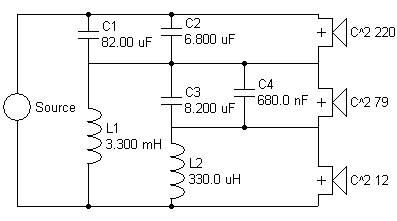
This filter sounds far from acceptable. It can be summarized as “listening through a tube”, or “canned sound”. The sound is very detailed, but way too bright, and fatiguing when playing loud (pressure on the ears with sopranos). The quality of the units is obvious. Reproduction of pulses are impressive (e.g drums). The tweeter is capable of reproducing metallic/sharp treble, but never becomes too shrill. There are no resonances in the low frequency range, but there is a lack of “body” (no pressure is built up). The crossover between the units doesn’t sound right. This is also obvious when moving your head in front of the speakers. It sounds as if different non-compatible sound sources are mixed, not sounding coherent at all.
At a later stage, when I was able to simulate this filter, it was clear why the filter sounded so bad. From the response it can be seen the units don't add well. The fundamental range is 5dB attenuated, the mid is 7.5dB louder than the fundamental, and treble is even louder.
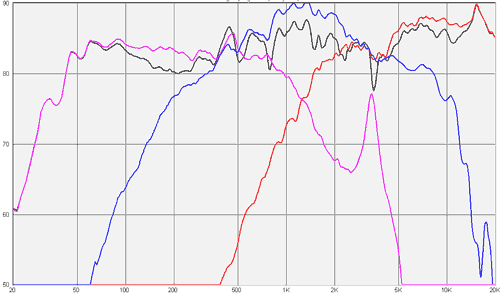
In a later stage simulations have been used to equalize the response by adding compensation circuitry in Speaker Workshop, based on Tony's curves. The resulting schematic and response are the following:

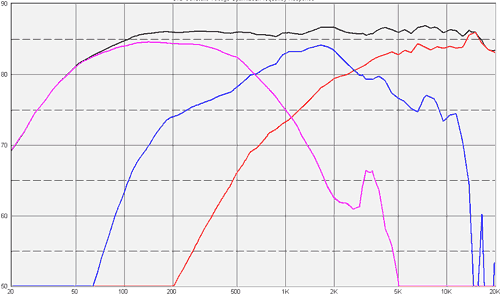
Overall this wasn’t an audible improvement at all. The result sounded dull, treble was “shut-in”, and not brilliant, the low-mid was not transparent and "muffled" in a large range (from 250Hz-750Hz), and the speaker was still missing fundament and pressure in the bass. Moving in front of the units makes obvious the units still don’t add nicely. It is as if you’re listening to 3 completely different loudspeakers. With coherent sounding speakers, this effect is always gone. Simulations with the anechoic curves available later in the project show a quite different response, less equalized, with fuzzy crossover regions (each about one octave wide):

In-house echoic measurements are close to the anechoic simulations, with a high-frequency roll-off due to measurement equipment limitations:
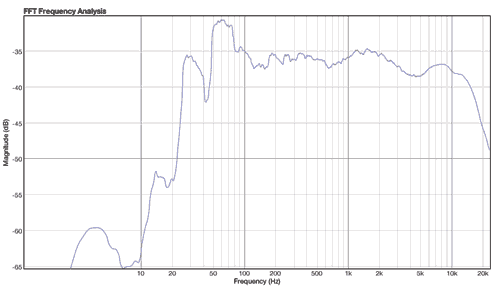
Reversing the phase of the midrange unit shows that the units have phase problems in their crossover region, and therefore don't add up well in the filter.
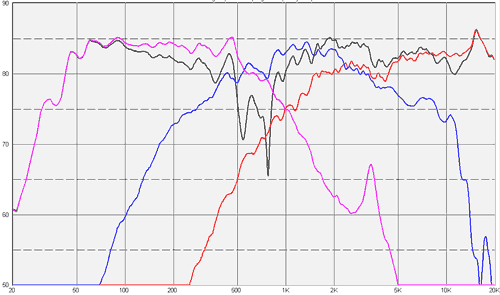
Soup filter [May 2005]
When we were struggling with the previous filter, Tony Gee published a Soup filter based on the C^2 79 and C^2 12, but with an Eton woofer. With a small change, this filter could be made suitable for the C^2 220 woofer as well. The resulting schematic is shown in the following figure: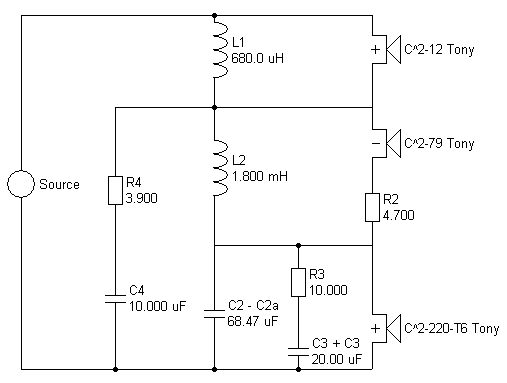
The following simulated response is based on Tony's curves:

This filter has some good and bad things. The muffled mid I had in the previous filter of the Milestones is gone, though there is still a huge amount of resonance, especially obvious when listening to piano. The treble sounds over emphasized, and fatiguing over longer listening. There is still no pressure in the fundamental and bass region. Resistors R2 and R4 have been tweaked, to accomplish a better overall balanced sound. Increasing their values created a more homogeneous sound, but also a bit dull.
When simulating the filter with the anechoic curves, it is obvious why it is difficult to balance the treble. There is a huge dip in the 2-10kHz region. Amplifying that region provides more treble, but at the expense of increasing the >10kHz region as well, resulting in sibilance.

One can also see that the crossover region between the midrange unit and tweeter is not designed correctly (when reversing the phase of the midrange unit, no dip occurs at the crossover point):

Serial-Parallel filter [July 2005]
One common observations of the previous filters is that the summed response curve is loosened from the curves of the separate units, especially for the midrange unit. After experimenting a lot with a series filter configuration, I didn’t manage to get the woofer to integrate properly with the midrange and tweeter section. Therefore I’ve decided to put the woofer in parallel to the midrange and tweeter section. The midrange-tweeter section is not a genuine series filter as well, as there is a reactive component (L4) in series with both components. Filter and response look as follows:
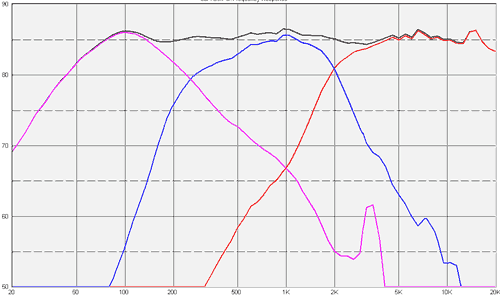
The overall impression of the filter is good. Finally music is playing in my room!!! There is a wall of sound, stereo and depth imaging is improved considerably. There is more body, and lots more involvement in the musical performance. There is still a bit resonance on the guitar tracks of Sharon Isbin, but this is a huge improvement of the previous versions of the Milestones. But, still lacking punch, and a bit more coloration in voices (like recorded in the 30s, baritone like, so too much upper mids) compared to the Soup filter. Simulations based on the anechoic curves available one year later again explain some of these these observations, showing a lack of fundamental (100-300Hz) and quite some prominent midrange (500-1000Hz), voicing (1000-2000Hz) and harshness (1500-3000Hz, strange tweeter curve).
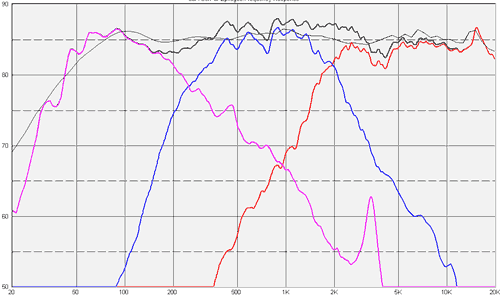
Phase inversion of the midrange units looks pretty OK, with dips occurring at the crossover points:

Some attempts to equalize the response have resulted in the following circuit:

The response looks pretty equalized, with a 3dB dip in the fundamental region:
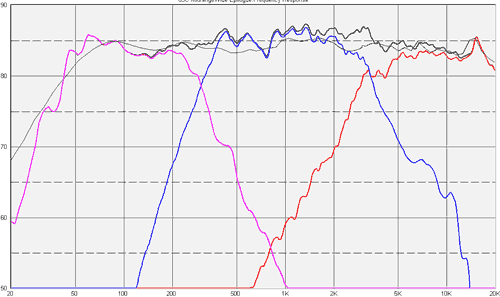
Besides reflections against the floor and ceiling (20-200Hz), the measured response shows quite some resemblance, with the treble a bit attenuated due to measurement distances:
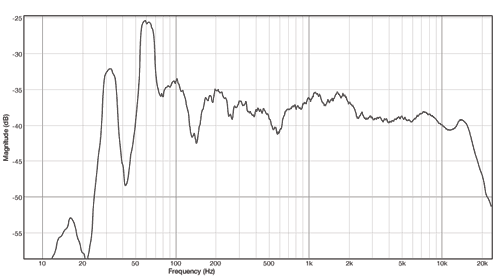
Also phase is quite OK, as shown by reversal of the midrange unit:
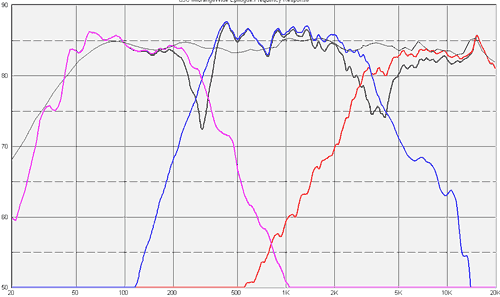
This filter exceeds all expectations. It is a huge improvement over the previous filters! First of all, there is more holographic spatial image! Compared to previous filters, the stereo image is apparent at any place in the living room. The sound is completely disconnected from the speakers. Secondly, there is more pressure in the low frequency region. With rock music still not at the full expected scale, but it is there for the first time. Cello and piano have good force in the low frequencies. Thirdly, the baritone and nasal coloration is much less apparent. Fourthly, the feeling of “live-performance” is large! A lot of music is fun to listen to, there is less tendency to change the music in the middle of a song, and about all CDs sound acceptable (e.g. a cello sonata of Beethoven used to sound too thin and baritone, and always left my CD player in the first minutes, now I’m enjoying it!). The filter still has some artifacts, but you can hear the artifacts becoming smaller. Though the filter has improved a lot, there is still some lack of warmth, and the overall sound still a bit on the analytical side. For instance, with rock music the punch is still not at the expected scale.
Conclusions
The following figure gives an overview of the above filters.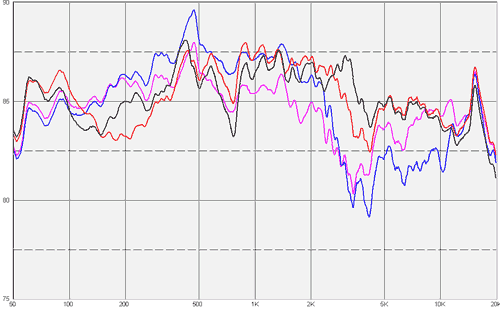

The last two filters show a more flat response, but there are still quite some deviations in the curves. There is an obvious resonance at 400Hz, the tweeter response is not flat, and in the fundamental range there is a dip. The main reason for these deviations is that these filters have been designed with unit curves that were measured under less than ideal situations.
The sound of the above filters ranges from bad to acceptable, but there is no filter that approaches a decent sounding speaker. Too much harshness, and lack of warmth are the main problems.
next->